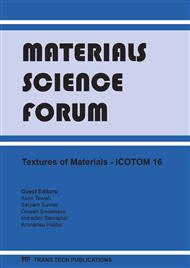p.56
p.60
p.64
p.68
p.76
p.80
p.85
p.89
p.93
Effect of Rolling Temperature on the Evolution of Microstructure, Texture, and Mechanical Properties of AZ31 Mg Alloy
Abstract:
Magnesium alloys have attracted a great deal of attention and have been extensively studied, but there is still a major obstacle to their practical application, namely, their poor formability at room temperature, which basically originates from their insufficient number of slip systems. The development of a microstructure and/or texture that is more conducive to formability is one promising solution that could improve their formability. In the present work, the microstructures, textures, and tensile properties of AZ31 Mg alloys are studied following extrusion and full annealing and rolling at 100 and 300°C. After full annealing, a strong ∥ED fiber texture and a weak + ∥ED fiber texture (c-axes in the radial direction) were developed. After 40% rolling at 100°C, many deformed twins were observed and a relatively weak texture was developed. The basal poles were split and rotated about 20° to the rolling direction (RD). During 60% rolling at 300°C, dynamic recrystallization (DRX) took place and a strong ∥ND fiber texture was developed, and this had an influence on the alloys’ poor formability at room temperature.
Info:
Periodical:
Pages:
76-79
Citation:
Online since:
December 2011
Authors:
Keywords:
Price:
Сopyright:
© 2012 Trans Tech Publications Ltd. All Rights Reserved
Share:
Citation:


